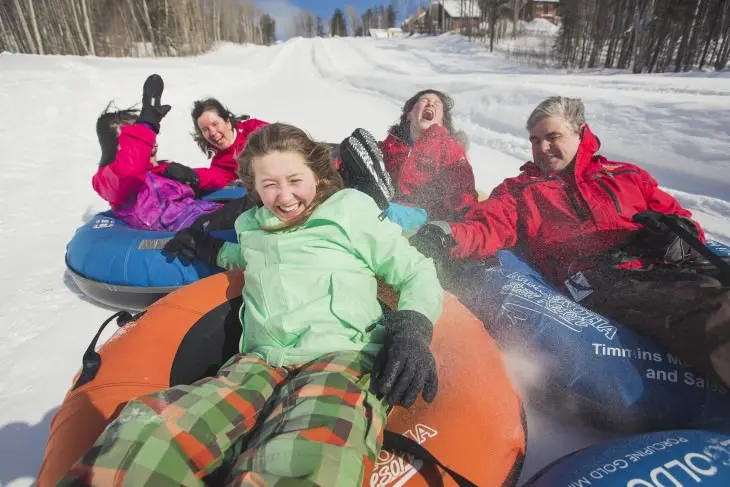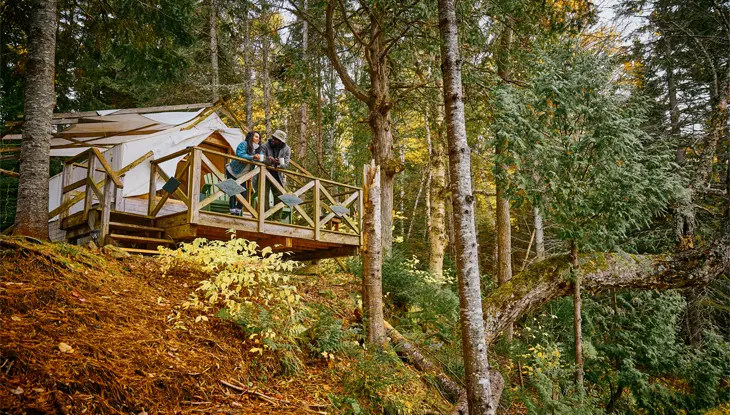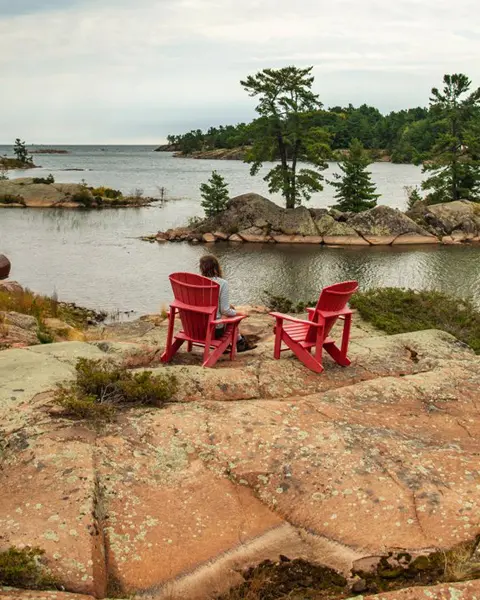Horseshoe Valley Resort
Horseshoe Valley Resort is one of Ontario’s finest getaway destinations for skiing, snowshoeing, golfing and year-round fun. The resort sprawls across 275 hectares of greenery, ski slopes, golf courses and trails.
Nestled in the picturesque Horseshoe Valley, this four-season resort features an array of on-site facilities including restaurants, accommodations, swimming pools, a spa and beautiful trails running through the Copeland Forest.
If you're looking for a getaway that allows you to reconnect with nature, rejuvenate your mind and delight your senses, look no further than Horseshoe Valley Resort.
Horseshoe Valley Resort | Krystle Forget
How to get to Horseshoe Valley Resort
Location: 1101 Horseshoe Valley Road West, Barrie
By car: Horseshoe Valley Resort is located north of Barrie in Simcoe County. There is free on-site parking and EV charging stations. Get detailed directions.
By transit: GO Transit offers regular train and bus service between Toronto and Barrie. Ontario Northland also offers bus service to Barrie. Take the Coach Canada SnowBus for a direct ride to the resort during the winter.
Know before you go
Horseshoe Valley Resort is a four-season resort and open year-round. However, numerous activities such as golf, biking and swimming are seasonal and weather dependent. Check the resort’s hours of operation to see what activities are currently available. Skiers and snowboarders can check the ski report for trail conditions in the winter.
Skiers are required to book rentals and lift tickets in advance.
Things to do at Horseshoe Valley Resort
Discover more activities and experiences.
Shred the slopes
Rent skis or a snowboard and hit Horseshoe’s 29 slopes, perfect for skiers of all levels. The resort boasts high-speed chair lifts, a snow machine and nighttime skiing and snowboarding.
Bike in nature
Cycle along 14 downhill mountain biking trails, which feature a good mix of terrains for seasoned and beginning riders. During the winter season, you can also fat bike in the snow.
Hike in the forest
Add hiking to your itinerary. The Salomon Trail takes you on a meandering path through the forest. For an extended trek, the nearby Copeland Forest is home to 70 kilometres of trails.
Soak up the sun
Take part in a variety of summer activities. Go off-road riding, reach new heights with rock climbing and Treetop Trekking, paddle around Horseshoe Lake and cool off in the water.
Play a round of golf
Book some tee time on the resort’s 12-hole golf course. With tree-lined fairways, natural ponds and beautiful grounds, the experience offers a delightful golfing challenge.
Unwind at a spa
Relax with a spa day at Amba Spa or the nearby Vettä Nordic Spa. Book facials, mani-pedis and massages or try out the age-old Finnish tradition of hydrotherapy.
Articles and itineraries
Get ideas and inspiration for your next trip.

Interesting facts about Horseshoe Valley Resort
Bill Lohuaru, a visionary home builder from Toronto, first opened the doors to Horseshoe Vallet Resort in 1962. At its opening, the ski resort had five slopes, two T-bars, a rope tow and a small base lodge. At the resort’s Silver Anniversary in 1987, the Inn at Horseshoe opened and welcomed its first overnight guests. Since then, it has grown into one of Ontario’s top four-season getaway destinations.
Horseshoe Valley Resort is named for the horseshoe-shaped series of hills in which the resort is nestled.
Ramps
An inclined plane that allows wheelchair users and others to access buildings and navigate between different levels.
Accessible restaurant
Designed to be accessible to persons with varying disabilities, including those using mobility aids. They include an accessible entrance, adequate maneuvering space, nearby accessible washrooms, tables with removable chairs and sufficient knee clearance, menus in alternate formats, and cafeteria or buffet counters that are reachable for mobility device users.
Accessible outdoor eating area
Places located outside where members of the public can sit at a table and eat (for example, outdoor food courts at amusement parks or picnic tables in parks). This includes accessible tables with enough clear space around and under so that people using a wheelchair or other mobility aid can easily access. Also, the ground leading to and under the accessible tables is level, firm and stable.
Support persons welcome
By law, you must allow a person with a disability to be accompanied by his or her support person while in the areas of your business that are open to the public. A support person is an individual hired or chosen by a person with a disability to provide services or assistance with communication, mobility, personal care, medical needs or with accessing goods, services or facilities. If you charge an admission fee at your business, you must let people know you charge an additional fee for a support person.
Service animals welcome
Can be identified by visual indicators (such as a vest or harness) or documentation from a regulated health professional confirming the animal is necessary due to a disability. In Ontario, service animals are allowed in all public spaces unless otherwise prohibited by law. A service animal is not a pet; it is trained to perform tasks to assist a person with a disability, such as guiding individuals with vision impairments, alerting to sounds for those with hearing impairments, assisting during seizures, retrieving items, or helping manage psychiatric and neurological disabilities. There are no restrictions on the type of animal used as a service animal in Ontario. If the animal is not easily identifiable, the person can provide documentation from a regulated health professional confirming the need for the service animal.
Accessible parking space
Accessible parking provides a place for people with disabilities to park and space to get in and out of their vehicles safely. It also provides access to the main accessible entrance and/or any other accessible entrances. Most users of wheelchairs need at least three feet of clearance to get in and out of their vehicles.
Emergency communication systems
Providing alerts and information in multiple formats including text-based alerts, audio messages and visual cues.
Last updated: September 2, 2025








